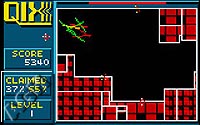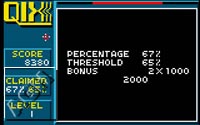|
QIX by Telegames
Unlike most abstract puzzlers, gameplay is totally free-form. You need to build squares and rectangles, at two speeds, scoring points for each portion of the playfield pre-emptied by their two-dimensional geometric figures. Meanwhile, a series of closely-spaced parallel lines, known as "Stix", wander freely around the screen, destroying any unfinished boxes it comes in contact with. On the early screens, the object is to either to fast or slow-draw enough boxes (slow-draw being worth more points) to fill in the predetermined percentage of the playfield without being destroyed by the Stix or the equally dangerous "Fuses." Fuses chase the player along its own perimeter the instant the "Qix" or drawing-point stops moving while you're in the process of constructing a box. Once a box is completed it fills up in either of two colors, depending on the speed of movement which you used in completing it.
The Lynx version of Qix is enhanced in subtle ways. Unlike the single colors of completed boxes in the original, each level in Lynx Qix has a different design pattern to fill in claimed space. Sound effects are quite simple but some digitized tunes augment the game nicely. One minor quibble with this version is in the control department -- it's much more stiff and unforgiving than its arcade cousin. This version requires precise input or you will find yourself furiously pressing down on the directional pad while watching your guy go nowhere. It doesn't detract that much from the game's playability, although you'll be required to concentrate much more on going where you want to. Overall, Qix is a conservative yet effective translation, and should appeal to both classic fans and puzzle aficionados alike. It's certainly not your usual run-of-the-mill action/puzzler, that's for sure.
|


